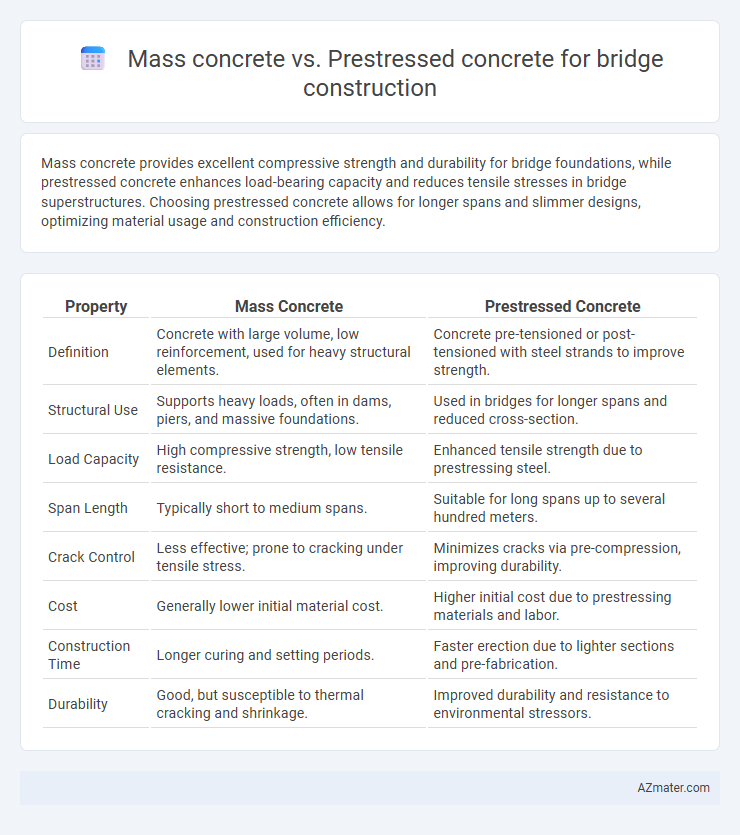Mass concrete provides excellent compressive strength and durability for bridge foundations, while prestressed concrete enhances load-bearing capacity and reduces tensile stresses in bridge superstructures. Choosing prestressed concrete allows for longer spans and slimmer designs, optimizing material usage and construction efficiency.
Table of Comparison
| Property | Mass Concrete | Prestressed Concrete |
|---|---|---|
| Definition | Concrete with large volume, low reinforcement, used for heavy structural elements. | Concrete pre-tensioned or post-tensioned with steel strands to improve strength. |
| Structural Use | Supports heavy loads, often in dams, piers, and massive foundations. | Used in bridges for longer spans and reduced cross-section. |
| Load Capacity | High compressive strength, low tensile resistance. | Enhanced tensile strength due to prestressing steel. |
| Span Length | Typically short to medium spans. | Suitable for long spans up to several hundred meters. |
| Crack Control | Less effective; prone to cracking under tensile stress. | Minimizes cracks via pre-compression, improving durability. |
| Cost | Generally lower initial material cost. | Higher initial cost due to prestressing materials and labor. |
| Construction Time | Longer curing and setting periods. | Faster erection due to lighter sections and pre-fabrication. |
| Durability | Good, but susceptible to thermal cracking and shrinkage. | Improved durability and resistance to environmental stressors. |
Introduction to Bridge Construction Methods
Mass concrete in bridge construction primarily involves large volumes of concrete poured without reinforcement, providing substantial weight and compressive strength to support loads. Prestressed concrete incorporates tensioned steel tendons that enhance load-bearing capacity and reduce material usage by counteracting tensile stresses, resulting in slender, durable structures. Choosing between mass and prestressed concrete depends on design requirements, span length, load conditions, and construction efficiency.
What is Mass Concrete?
Mass concrete is a large volume of concrete with dimensions large enough to require careful consideration of heat generation from cement hydration and its effects on structural integrity, commonly used in bridge foundations and piers. Unlike prestressed concrete, which incorporates tensioned steel tendons to enhance strength and reduce material usage, mass concrete relies on its substantial cross-sectional area to bear heavy loads and resist environmental stresses. Proper temperature control and curing methods are critical in mass concrete to prevent thermal cracking and ensure long-term durability in bridge construction.
Defining Prestressed Concrete
Prestressed concrete is a specialized form of concrete in which internal stresses are introduced before external loads are applied, improving structural performance by counteracting tensile stresses. Unlike mass concrete, which relies on its sheer volume and compressive strength to bear loads, prestressed concrete uses high-tensile steel tendons or cables tensioned within the concrete to enhance durability, reduce cracking, and allow longer spans in bridge construction. This technique results in lighter, more efficient bridge components with superior load-carrying capacity and increased resistance to dynamic forces.
Key Differences Between Mass Concrete and Prestressed Concrete
Mass concrete in bridge construction involves large volumes of concrete poured without significant reinforcement, designed primarily to resist compression and provide substantial weight and stability. Prestressed concrete incorporates high-strength steel tendons tensioned before or after casting, enhancing tensile strength and allowing longer spans with reduced material usage. Key differences include the role of reinforcement, with mass concrete relying on its mass for stability, while prestressed concrete uses induced stresses to counteract loads and improve performance.
Structural Performance Comparison
Mass concrete exhibits high compressive strength and durability but is susceptible to cracking due to thermal stresses and shrinkage, limiting its structural performance in bridge construction. Prestressed concrete enhances load-carrying capacity and structural efficiency by inducing compressive stresses that counteract tensile forces, resulting in improved crack resistance and longer spans. The superior tensile performance and stiffness of prestressed concrete make it preferable for modern bridge designs requiring reduced maintenance and higher durability.
Durability and Longevity Considerations
Mass concrete offers excellent durability due to its substantial cross-sectional area, reducing permeability and resisting environmental degradation over time. Prestressed concrete enhances longevity by actively counteracting tensile stresses, minimizing crack formation and thus improving resistance to fatigue and corrosion. Both methods extend bridge service life, but prestressed concrete provides superior control over structural behavior, resulting in enhanced durability under dynamic loads.
Cost Implications of Mass vs Prestressed Concrete
Mass concrete requires higher initial material costs due to substantial volumes of cement and aggregate, while prestressed concrete involves greater upfront expenses for specialized materials and skilled labor related to tensioning systems. Despite higher initial costs, prestressed concrete offers long-term savings through reduced maintenance and extended durability, making it cost-effective for longer span bridges. Conversely, mass concrete's lower technical complexity can reduce initial labor costs but may increase total lifecycle expenses due to heavier structural elements and potential for cracking.
Construction Time and Complexity
Mass concrete involves simpler construction techniques with longer curing times, resulting in extended project durations for bridge construction. Prestressed concrete, using high-tension cables, allows faster assembly and reduces curing time, significantly accelerating bridge construction timelines. The complexity of prestressed concrete requires skilled labor and precise engineering, whereas mass concrete relies on more straightforward processes.
Suitability for Various Bridge Types
Mass concrete is ideal for heavy-load-bearing structures such as arch and gravity dams where large volumes are required, offering excellent durability and resistance to weathering. Prestressed concrete excels in long-span bridges like box girders and cantilever bridges, providing high tensile strength and reducing material usage due to the pre-applied compressive stress. Selection between mass and prestressed concrete depends on bridge span length, load conditions, and structural requirements, ensuring optimal performance and cost-efficiency.
Future Trends in Concrete Bridge Construction
Future trends in concrete bridge construction emphasize the increasing adoption of prestressed concrete due to its superior durability, load-bearing capacity, and reduced material usage compared to mass concrete. Innovations in high-performance prestressing materials and advanced monitoring technologies enable longer spans and enhanced structural health management. Sustainable practices are also driving research toward optimizing prestressed concrete mixtures for carbon footprint reduction while maintaining strength and longevity.

Infographic: Mass concrete vs Prestressed concrete for Bridge construction
 azmater.com
azmater.com